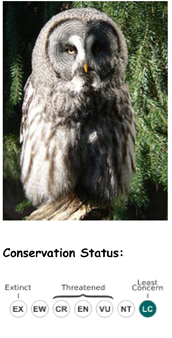Learn About Great Grey Owls
The Great Grey Owl or Lapland Owl (Strix nebulosa) is a very large owl, distributed across the Northern Hemisphere.
Adults have a big, rounded head with a grey face and yellow eyes with darker circles around them. The underparts are light with dark streaks; the upper parts are grey with pale bars. This owl does not have ear tufts and has the largest facial disc of any raptor.
The length ranges from 61 to 84 cm (24 to 33 in), averaging 72 cm (27 in) for females and 67 cm (26 in) for males. The wingspan can exceed 152 cm (60 in), but averages 142 cm (56 in) for females and 140 cm (55 in) for males. The adult weight ranges from 700 to 1800 grams (1½ to 4 lb), averaging 1290 grams (2 lb 14 oz) for females and 1000 g (2 lb 3 oz) for males. The males are usually smaller than females, as in most owl species.
They breed in North America from Lake Superior to the Pacific coast and Alaska, and from Scandinavia across northern Asia. They are permanent residents, but may move south and southeast when food is scarce.
Their breeding habitat is the dense coniferous forests, near open areas, such as meadows or bogs. Great Grey Owls do not build nests, so typically use nests previously used by another large bird. They will also nest in broken-topped trees and cavities in large trees. Nesting may occur from March to May. 4 eggs is the usual clutch size. The incubation period is about 30 days.
The abundance of food in the area usually affects the number of eggs a female lays, a feature quite common in northern owl species. If food is scarce, they may travel a fair distances to find more prey, with considerable movements by large numbers in some years of particularly scarce prey. Though they do not migrate, many are at least somewhat nomadic.
They have excellent hearing, and may locate (and then capture) prey moving beneath 60 cm (2 feet) of snow in a series of tunnels solely with that sense.
Great Grey Owls rely almost fully upon small rodents, with voles being their most important food source.
The harvest of timber from the Great Grey Owl’s habitat is, perhaps, the greatest threat to this species. Intensified timber management typically reduces live and dead large-diameter trees used for nesting, leaning trees used by juveniles for roosting before they can fly, and dense canopy closures in stands used by juveniles for cover and protection. If perches are not left in clearcuts, Great Grey Owls cannot readily hunt in them. Although human-made structures (made specifically for use by this species) have been utilized by these owls, the species is far more common in areas protected from logging.

Scientific Classification:
- Kingdom: Animalia
- Phylum: Chordata
- Class: Aves
- Order: Strigiformes
- Family: Strigidae
- Genus: Strix
- Species: S. nebulosa

References: *BirdLife International (2004). Strix nebulosa. 2006 IUCN Red List of Threatened Species. IUCN 2006. Retrieved on 06 May 2006. Database entry includes justification for why this species is of least concern.

